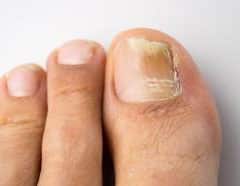 Onychomycosis is a nail disease caused by fungi . This is a chronic infection that is also called ringworm of the nails or tinea unguium .
Onychomycosis is a nail disease caused by fungi . This is a chronic infection that is also called ringworm of the nails or tinea unguium .
The causes of onychomycosis are usually dermatophytes , although the disorder can also develop due to the action of molds and yeasts . The problem usually appears in the nails of the big toes, but it can break out into other fingers and even the hands.
Several reasons are capable of causing onychomycosis. Wearing inappropriate footwear, sports activities, poor circulation in the extremities, diabetes , and poor nail cutting are potential risks.
Onychomycosis is generally detected by a change in the color and thickness of the affected nail . Other symptoms are not common: in rare cases, changes in appearance are accompanied by discomfort or pain.
Onychomycosis is primarily a cosmetic problem. The nails become deformed and yellowish, losing their natural shade.
It is worth mentioning that onychomycosis is the disorder that human beings contract most frequently in the nails and can be the cause of more than 50 percent of cases of onychodystrophy , the name given to any alteration in the structure or morphology of the nails. nails.
In a large number of cases of onychomycosis, around 90 percent, the fungi that cause it can also affect the hair and skin; These are dermatophytes: Trichophyton mentagrophytes, Trichophyton rubrum and Epidermophyton floccosum are some of the most common, while Mycrosporum spp appears less frequently. The remaining 10 percent arise from non-dermatophyte filamentous fungi and yeasts (molds and Candida , respectively).
The treatment of onychomycosis is complex since the fungus , upon penetrating the nail, becomes almost inaccessible. The podiatrist can provide antifungal medications that are applied to the infection periodically and over an extended period.
If the drug is taken for too long, certain side effects are likely to appear, which is why periodic monitoring is necessary. Another consequence that this treatment can have is the interaction between medications, an unwanted reaction that sometimes decreases or increases their action or causes adverse effects.
 Another possibility is to treat onychomycosis with a laser . The purpose is to prevent the reproduction of fungi and achieve their elimination. In any case, a professional must be the one who diagnoses onychomycosis and then determines the treatment to follow.
Another possibility is to treat onychomycosis with a laser . The purpose is to prevent the reproduction of fungi and achieve their elimination. In any case, a professional must be the one who diagnoses onychomycosis and then determines the treatment to follow.
Speaking specifically about the clinical control and diagnosis of onychomycosis, it usually presents certain complications, for several reasons. First of all, the doctor must evaluate the possibility of any systemic or skin disease that could negatively impact the nails with similar symptoms, and this requires microbiological studies . But even following this recommendation responsibly, these tests do not offer 100% reliable results.
No matter how much we follow a treatment indicated by a professional, onychomycosis is a disease that can cause relapses quite frequently, so that some people suffer from it for several decades. Age is another factor that increases the chances of its appearance, which is why it is much more common among elderly men. This is because nails take longer to grow in old age, and this is combined with the deformities that usually arise from alterations in walking.
According to statistical studies, we know that onychomycosis is more common in men than in women and that it is influenced by socioeconomic, professional and climatic issues; Therefore, its prevalence is different in each part of the world.
